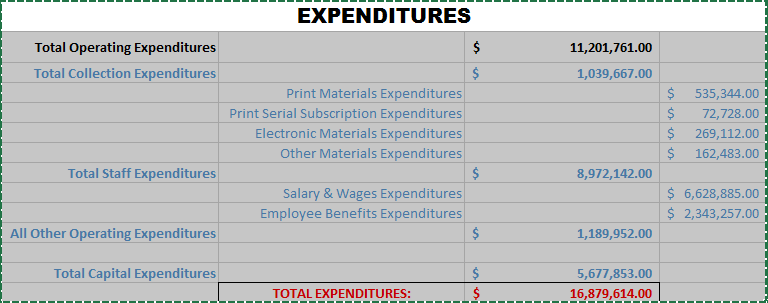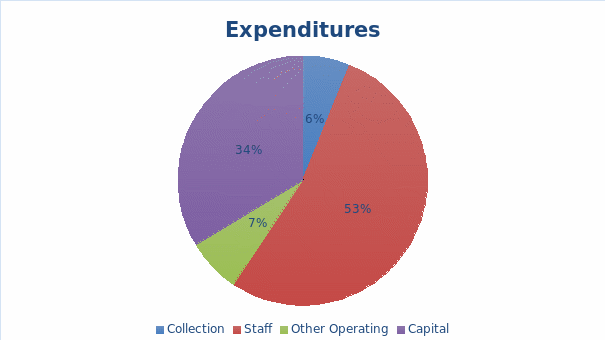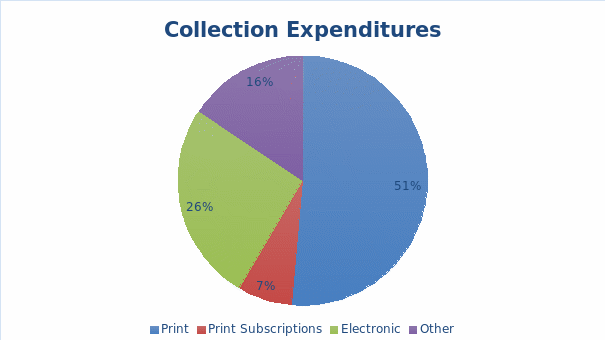Executive Summary
After careful analysis of Santa Monica Public Library’s financials, it is concluded that SMPL and its branches can cut costs if they were to reduce costs in two main areas: salaries and wages, and print materials. With current expenditures in both areas over 50% of all total expenditures, one expects that Santa Monica Public Library could potentially save a lot of money that would be better used toward developing other thematic and community building spaces and events. Implementation of these alternatives would include automating the central library cataloging system.
Consequently, overhead costs would reduce because of a decline in the number of staff librarians. Further, the number of electronic sources/literature available to beneficiaries would also increase. While the implementation of the alternatives would require substantial investment cost, in the end, it would benefit the library. By staying relevant to the 21st century’s digital revolution, established libraries must be able to adapt and ensure that libraries remain a key part of society’s commitment to education and knowledge.
Introduction
The purpose of this cost analysis report is to analyze the costs of the Santa Monica Public Library and determine its benefits to the cardholders it serves. It is often difficult to determine the cost/benefits provided by a public good or service due to the value that it brings to the community. While many would agree that the Santa Monica Public Library is quite valuable to its community, it is difficult to communicate a library’s value in dollars. Most public libraries are mainly local, in that they serve mostly only the members of the community in which they reside.
Santa Monica Public Library does not attract a lot of money from outside the local economy. Most of the funds are raised through fundraisers, gifts, grants, and in-kind contributions; the remaining funds are sourced from taxes. With such scarce resources, cost analysis is helpful in determining whether a public good, such as the Santa Monica Public Library, is using its resources to its maximum potential.
A comprehensive description of the public good or service
Santa Monica Public Library (SMPL) is recognized as a community, cultural and learning center with the mission to offer resources, services, and a center to read, socialize, relax and learn. SMPL promotes literacy, civic involvement, life-long learning, and cultural awareness (Santa Monica Public Library 1).
The history of the Santa Monica Public library is quite long and respectable. In December of 1890, the first City Librarian was appointed, and since then, the Santa Monica Public Library (SMPL) has grown and developed to be a beloved safe space for young and old to enjoy. SMPL has expanded to other five different locations, including Main, Fairview, Montana, Ocean Park, and Pico. These five library locations are included in this review. SMPL offers a number of different programs and services to three main groups of people, general households, teachers, and businesses. Over the course of the last five years, SMPL has consistently increased the number of adult programs offered to 796 programs in the fiscal year of 2014-2015. Youth programs in the same year also increased to 1636. From book readings to computer classes, SMPL libraries provide a large number of services and events that help engage its patrons.
From information sourced from the SMPL Web site, the library seems to be quite successful in its ability to provide literature to its community and the demands for its services increase. In the fiscal year of 2014-2015, there were over 1.2 million visits, not including about 799,426 virtual visitors on its Web site. Registered users are also quite high, relative to the population. From the California Public Library Statistics Portal, it was established that by the end of the fiscal year 2013-2014, SMPL had 103,320 registered households and patrons, with a total population of 104,079.
The registration percentage based on this datum is over 99%. It also carries over 449,000 items in collection, in print, and contains over 1.5 million items in total circulation, including electronic items. Its patrons seem to be quite delighted and satisfied with the kind of service provided by SMPL – surveys returned showed a satisfactory rating of over 90% in several different areas. Beneficiaries were asked if the libraries were offering the materials that met their needs, providing satisfactory customer service, and maintaining equipment and facilities for most effective and efficient beneficiary use. Each of these questions received over 90% satisfactory rating. Overall, the Santa Monica community seems to like its public libraries for the services and goods it provides as it continues to support the development and growth of SMPL.
The Current Cost Provision
Costs and Income
There are generally two economic dimensions in the evaluation of a cost: the value of resources used and opportunity cost. In addition, there are two measurement dimensions: units of analysis and time. In addition, the cost can also be evaluated in two ways as indirect cost and direct costs.
In this section, the cost of running SMPL is analyzed. Sources of funds are identified, including tax revenue, gifts, grants, donations, fundraising, and other fees associated with service usage at the library.

As shown in Table 1.1 above, there are three general types of income for the Santa Monica Public Library. They are income from the local government, in other words, local tax collection revenues, federal income, which is federal tax revenues, and “other operating income”. Other operating incomes emanate from different income sources. A portion of this could be from fundraising where the public library hosts events such as galas or golf tournaments in order to raise funds for its operation. Libraries can also collect fees for items that have not been returned (lateness penalties) to the library on time. These revenues are more variable because they depend on irresponsible behaviors of patrons such as lateness when returning books and other borrowed items back to the library. Finally, Santa Monica Public Libraries also have technology centers where patrons can use computers and printers for a small fee. In each fiscal quarter, the board will review these revenues to see if they are on track for the estimated revenue target.
Surprisingly, revenue comes mostly from the local government taxes, not state or federal.
Next, the report looks at the costs of providing services at the Santa Monica Public Libraries.

As can be observed in the table above, total expenditures equate to $16,879,614.00. This includes all expenditures on print and electronic collections, staff, as well as capital expenditures. Capital expenditures of $5,677,853.00 include expenses that were used to purchase fixed assets such as land, buildings, and equipment among others.

From the operation alone, all the five libraries of SMPL spent a total of $11,201,761.00 for operation in the fiscal year of 2013-2014. One can observe that staff expenditure was a major component of the expenses. The Santa Monica Public Library employs 201 staff members across all its five locations. Staff expenditures consisted of 53% of the total expenditures while capital expenditures consisted of 34%.
Specifically, two types of operating expenditures exist. Collection expenditures are expenses required to maintain the current collection (the main goods) in the public libraries. Collection expenditures can then be separated into three different types of expenditures, namely print materials (books, magazines, articles, newspapers, including subscriptions), electronic materials (e-books, e-magazines, newspapers), and other materials (movies, documentaries, and audiobooks among others).

As expected, the collection expenditures consist mainly of print materials. This discovery is consistent with current expectations of libraries, which is to provide literature, usually print (in the forms of books, magazines, and newspapers), to its patrons. The pie chart above shows visually the make-up of collection expenditures. Print material expenditures, purchasing books and other literature consisted of 51% of all collection expenditures, while 26% consisted of electronic expenditures. On this note, a classical study done on economic of the public library in Beverly Hills established that benefit/cost ratio was important for libraries to consider when reallocating book budgets to frequently used books (Newhouse and Alexander 7).
Per-Capita


The above per-capita values are derived using the total legal service population number, 92,185. From the numbers in the table, one can see that cost per beneficiary is $121.51. However, this cost only includes the costs are incurred as operating expenses only. The cost is associated with the new library in Santa Monica community that was developed two years ago at Pico. As such, capital expenditures have significantly increased in the last two fiscal years.
To gain a better perspective on the actual consistent cost of the public libraries, only operating expenses should be included in the per-capita account. However, to keep the reader well informed and enhance prudence, per-capita expenditure values are provided here including capital expenses. Expenditures per-capita including capital expenditures are valued at $183.11 per person.
There is no evident off-budget or hidden costs in the expenditure of the library. Such practices have been known to weaken budget control and, therefore, the Library strives to avoid them (Schick 2). Hence, it can be said that the library strives for financial prudence by ensuring that all the necessary items are included during accounting processes (Finkler et al. 464).
Alternative Provision Methods
Cost Reducing Alternatives
It is interesting to note that once the cost of the Santa Monica Public Libraries was determined, two large costs seem to overwhelm all other categories of expenditures in the budget of SMPL. The first is staff expenses, which consists of 53% of all expenditures in the budget. The second is print collection expenses, which consist of 51% of all collection expenses.
According to the California library statistics portal, Santa Monica Public Library employs 201 employees, not including the full-time volunteers that are at the libraries (California State Library 1). The total employee salaries, wages, and benefits add up to over $8 million. This figure is well over half of all of the expenses of the libraries located within the Santa Monica Public Library jurisdiction. Based on this observation, it is therefore imperative for the libraries to explore further the option of automating the public libraries in the Santa Monica jurisdiction.
Many libraries currently have computer centers as well as computers that allow patrons to search the internet or the library catalog for books or literature that they may be of interest to them. Some libraries even have self-check-out stations, which are implementations that can be crucial to the reduction of costs at the Santa Monica Libraries. Minicomputers and desktops were at one point too expensive to consider, but with the computer industry consistently creating and improving computers, they have become rather inexpensive. Of course, these costs lead to other costs such as expensive equipment, specialized software, training, consultant fees, and support and maintenance are all variables that may drive computerization costs upwards. In addition, out-of-pocket costs for planning and consulting could also be a cost that is not expected and increases the overall cost of migrating to an automated circulation system. However, with the help of computers and automated systems in the libraries, human labor can be reduced, which will significantly lower the costs of the libraries.
The second area of improvement where costs can be reduced is in the print expenditures. Currently, the library spends approximately 51% of its collection expenditures on print materials. Such costs may include purchasing more than one copy of a book, magazine, or newspaper. One way a library can save resources is by purchasing fewer copies of the same literature and implementing an online book source where patrons can access these books without running the risk of experiencing a shortage of copies.
Currently, several privately held companies are diving into the electronic and digital world. Companies such as Amazon and Barnes and Noble have begun selling reading tablets that include books and books to purchase where avid readers and users can read a book at not only a cheaper price but at more convenience to them, too. While the average book on Amazon may cost anywhere between $5 and $10, a print material maybe double or even triple the price (Bellis 1). Purchasing these books digitally would be so much more efficient than purchasing the printed versions. Of course, the library should not strive to replace all printed materials. There are still plenty of individuals, who would rather hold a book in their hands instead of a reading machine. Given the continuous development of the technological world, it would be wise for the libraries to follow suit as well and adopt technologies to cut costs (Cohn and Kelsey 1).
Implementation and Limitations
Implementation of these changes would require more resources and time. The initial investment would require the libraries to estimate and take into consideration new equipment costs, staff training costs, construction costs, and software costs. Of course, these costs would be offset by the efficiency with which the library would be able to run and help decrease the amount each library spends on staff salary and wages. Rather than hiring one to two extra librarians just to take care of checkout and drop-offs, librarians can focus on what they are truly trained to do – to help others locate resources and information.
However, with this comes also the necessary skill of being familiar with the technology. A librarian would now need to be able to use a computer and its features with skill and efficiency, which would require training. This would also mean that a librarian’s position salary would increase because the job would actually be more demanding. In addition, the library would be required to make a certain renovation to create more room for the self-check-out stations or drop-off stations at the library.
In addition, the library would also need to increase the number of electronic sources available to its patrons. Doing so would require more electronic resources. Many libraries are now purchasing reading tablets that allow patrons to read digitally. Implementing this strategy requires a slightly higher initial cost.
It is recognized that implementation difficulties would emanate from initial costs of investments, which are most likely to be higher than the current budget of the libraries. For these solutions to be approved and executed, libraries can apply for grants or fundraise for the capital. Both of the recommendations above may also require state/local government approval because changing specific construction within the library or changing software/technology systems normally requires approval from senior state officers.
Although these proposals seem to be good, patrons may not as easily accept increasing the number of electronic articles/literature in circulation. Technology illiteracy, for instance, could be a barrier specifically for many adults who prefer print materials rather than electronic copies of the literature they cannot retrieve efficiently.
Therefore, the library must account for all stakeholders, including the government, library patrons and staff when implementing these proposals to avoid resistance. When all stakeholders are involved, then project would be politically feasible and minimize possibilities of rejection. They must understand cost/benefit drivers of the proposed solutions (Wright 209).
It has been interesting to see that the libraries have begun to change and transform, developing into a new ‘hub’ for a range of new community events such as book readings, summer reading programs, and even performances. These spaces often reflect not only the needs of the community in terms of providing knowledge, but also the needs and aspirations of a particular community. It is important to know that these spaces have become public safe houses for students, teachers, households, and even business owners. Through its services and organized events, social engagement, community building, and associated programs have begun to become a part of the library identity, as it seeks to provide comfort and inspiration to not only the young learners, but also the adults.
Works Cited
Bellis, Rich. “Average Price Rises on Ebook Best-Seller List, but Few Signs of Agency Pricing.” Digital Book World. 2015. Web.
California State Library. California Public Library Statistics: Ready Reports. 2015. Web.
Cohn, John M. and Ann L. Kelsey. Planning for Automation and Use of New Technology in Libraries. n.d. Web.
Finkler, Steven A, Robert M. Purtell, Thad D. Calabrese and Daniel L. Smith. Financial Management for Public, Health, and Not-for-Profit Organizations. Pearson Prentice Hall: Upper Saddle River, NJ, 2013. Print.
Newhouse, Joseph P. and Arthur J Alexander. An Economic Analysis of Public Library Services. Washington, D. C: The RAND Corporation, 1972. Print.
Santa Monica Public Library. Santa Monica Public Library: Strategic Plan. n.d. Web.
Schick, Allen. “Off-Budget Expenditure: An Economic and Political Framework.” OECD Journal on Budgeting 7.3 (2007): 1-32. Print.
Wright, G A. “Shall we circulate automatically?: A cost benefit analysis of Newcastle Polytechnic Library’s automated circulation control system.” Program Electronic Library and Information Systems 15.4 (1981): 209-225.